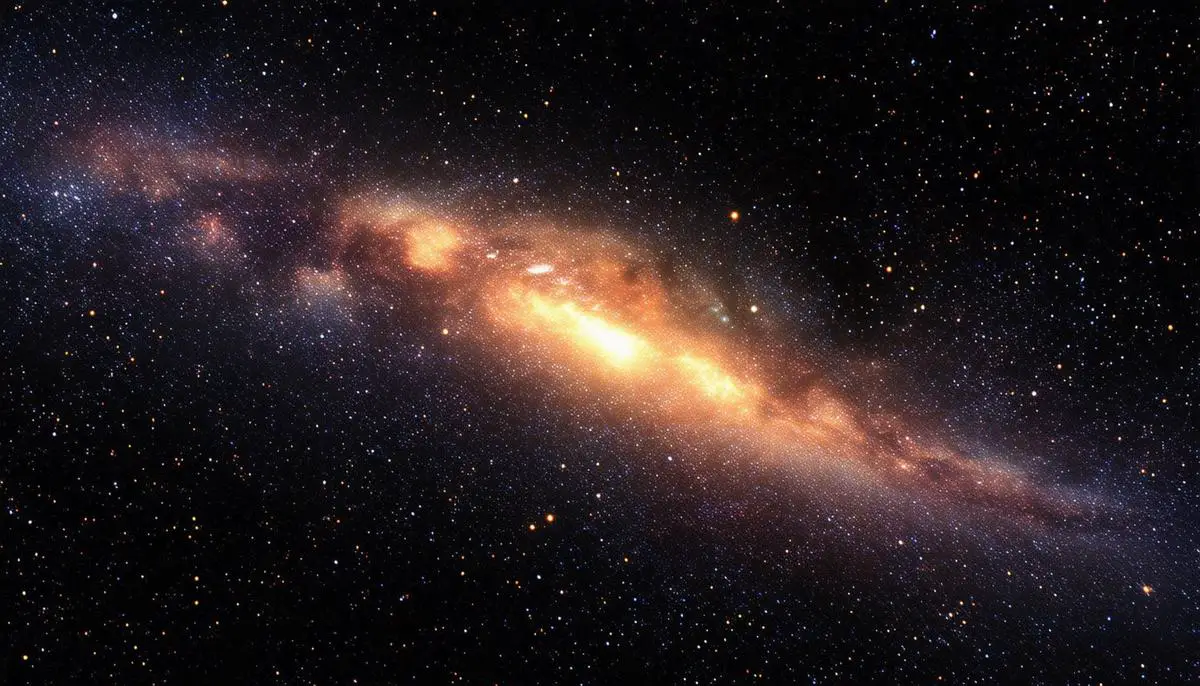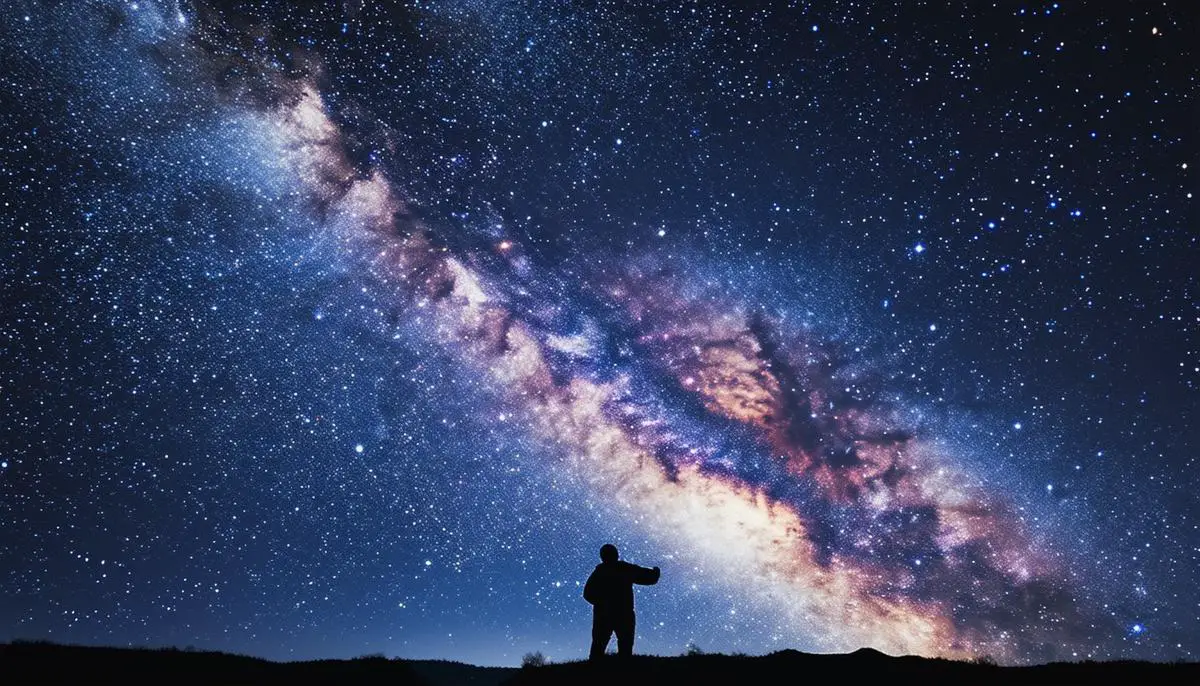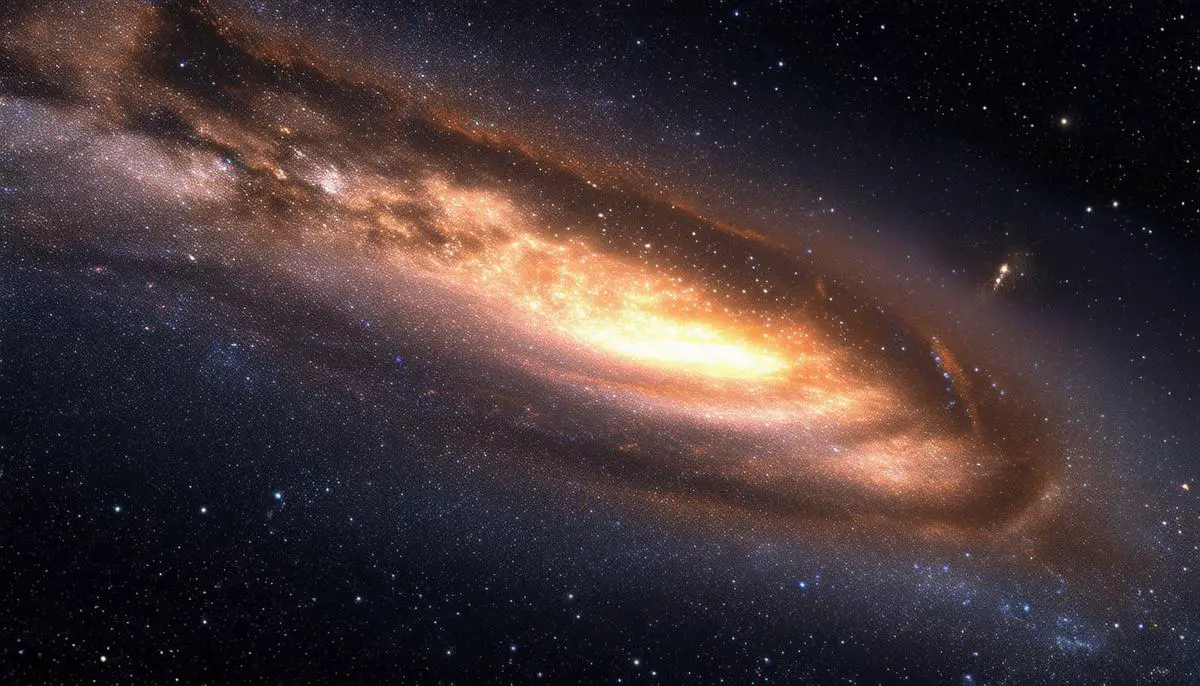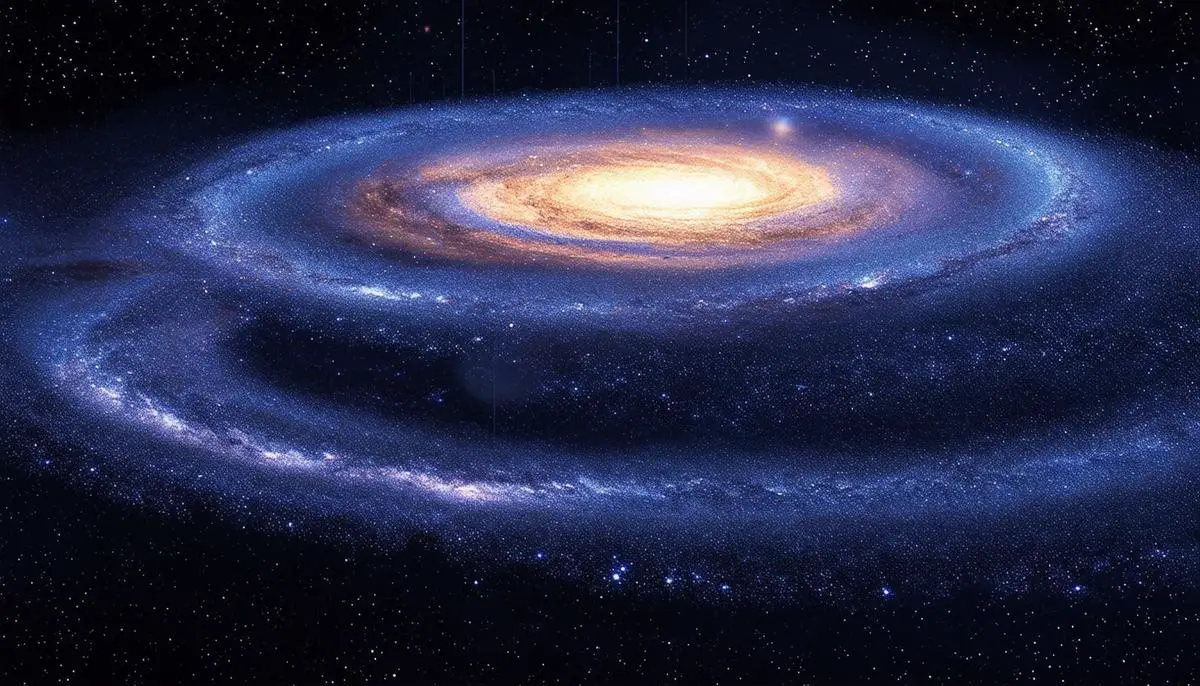Galactic Structure and Star Distribution
The Milky Way, our home galaxy, extends approximately 100,000 light-years in diameter and features a complex structure comprised of a central bulge, four major arms, and supplementary minor arms such as the Orion-Cygnus Arm, which harbors our sun. The galaxy's bulge, approximately 10,000 light-years across, teems with ancient stars, predominantly old red giants. This densely packed area acts as both heart and anchor to the galaxy's swirling limbs, with gravity maintaining its grip on the entire structure, including the bar from which the major spiral arms extend.
The thin disk of the Milky Way offers a spatial vista where star density eases and new stars emerge from interspersed clouds of gas and dust. The Orion Arm, in particular, affords astronomers clearer skies for stellar scrutiny due to its younger, less densely packed stars. The Milky Way's disk also exhibits a warped characteristic, undulating above and below an invisible median point marked by centuries of rotational trajectories. This warp influences the precession of star orbits within the disk, affecting starlight accumulation and distribution.
The major arms, such as the Perseus and Scutum-Centaurus arms, serve as focal regions for star formation, where hydrogen clouds condense under their own gravity to birth new stars. Lesser-known bands, like the Local and Sagittarius arms, play subtly influential roles in managing fewer stars but contribute to the Milky Way's stability and stitched appearance.
Exploring and understanding these stellar threads is imperative, as each modifies the celestial chronicle visible from Earth. While the average stargazer revels in a mere fraction of this grand design, astronomy continually unveils the celestial millions typically veiled by distance or dust within this galactic haven. Each galactic quarter, from bulge to fringe, influences star density and viewability, offering an enduring reflection on the universe's intricacy and our perpetual curiosity for unraveling its wonders.

Estimating Star Numbers
Estimating the number of stars in the Milky Way provides insight into the expansive scope of our galaxy and the depths of our scientific endeavor. The process involves determining the galaxy's mass, which is essential for inferring star count. This is often derived through the dynamic choreography of star movements, as their speed and rotation divulge clues about the mass ensnared by the galaxy's gravitational field. Observations of these parameters allow astronomers to quantify dark matter and determine how much of the total galaxy mass is attributed to stars.
Spectroscopy is another crucial technique, scrutinizing the light emanating from the galaxy to identify the various elements present within the Milky Way. Differences in spectral lines can indicate which part of a galaxy is moving toward or away from us under the galaxy's rotational momentum. These variances enable astronomers to create detailed maps of stellar orbits, revealing mass distribution and hinting at overall star count. However, the galaxy's orientation relative to Earth and the precision of these astronomical measurements complicate immediate assumptions and interpretations.
The Gaia mission, launched by the European Space Agency, has been instrumental in mapping the heavens with unprecedented detail. Utilizing Gaia's expansive data, scientists extrapolate broader galaxy models. However, many stars defy easy classification or detection, particularly faint red dwarfs or indeterminate brown dwarfs.
Given these hurdles, estimating the total number of stars in our galaxy becomes an exercise in theory, innovation, and observation. Challenges include the lingering enigma of what proportion of galactic mass composes its starry canvas, the variable spectra emitted by different star types, and vast spans of cosmological distance. Yet, each obstacle surmounted provides another piece in this grand cosmic puzzle, deepening our understanding of the galaxy's structure, evolution, and future.

Comparative Star Formation Rates
Exploring star formation rates in the Milky Way and neighboring galaxies, such as the Andromeda Galaxy (M31), sheds light on the forces that drive galactic evolution. Both spiral galaxies foster new stars at contrasting rates, with the Milky Way producing six to seven new stars annually, while Andromeda generates only one to two.
In the Milky Way, star formation primarily occurs in cold, dense hydrogen gas within molecular clouds. The stars that predominantly emerge are red dwarfs, the most common stellar denizens throughout our galaxy. Andromeda's relatively subdued star formation rates raise questions about differences in available molecular gas, accretion efficiency, or interactions with neighboring satellites.
Comparing star formation rates across galaxies reveals a kaleidoscopic view of galactic diversity. Planetary nebulas and intricate dust lanes stand as witnesses to the births of stars in the unfolding timeline of galaxy lives. These disparities in star formation influence galactic longevity and dictate the dynamics within each cosmic isle.
- Milky Way: 6-7 new stars per year
- Andromeda (M31): 1-2 new stars per year
- Starburst galaxies: Hyperactive star formation during mergers or in extraordinarily dynamic regions
Each galaxy crafts its story based on its contents and relationship with the universe's broader fabric. By probing these celestial births, we fathom the nows of nascent stars, the yesterdays of their gathering dust, and the tomorrows of potential supernovae. Andromeda's restraint and our Milky Way's middling diligence offer precious footholds in our evolving grasp of the cosmos.
Role of Dark Matter in Star Count
Dark matter, an elusive yet pervasive element, profoundly impacts the gravitational foundation of galaxies and influences the formation and distribution of stars. In the Milky Way, dark matter envelops the visible components in a colossal halo, serving as an astrophysical scaffold. Its gravitational pull accelerates the infall of gas across the galaxy, enabling gas clouds to reach densities sufficient for star formation.1
The role of dark matter extends to crafting the thermal properties of gas clouds. High concentrations of dark matter may hasten gas cloud collapse, sparking a flurry of star formation, while areas with less dark matter might witness slower stellar births. This modulation by dark matter is pivotal in calculations concerning the galaxy's total stellar populace. Standard models for galactic formation rely on understanding dark matter's distribution to predict star spread across different galaxy types.
Quantifying dark matter's influence presents significant challenges, as it does not interact with electromagnetic forces in a way that we can currently observe. Astronomers and astrophysicists must infer its presence and effects indirectly by examining the rotational speeds of galaxies and the movement of galaxy clusters, using techniques rooted in gravitational lensing and cosmic microwave background studies.2
If dark matter were ultimately accounted for with greater accuracy, estimations of star counts could undergo substantial revisions. As these invisible halos bind the visible features of galaxies and wield influence over star formation and aggregation, appreciation of dark matter becomes necessary for a theoretical framework and a holistic view of our galaxy.
Future insights into dark matter could unravel more than just the spine of galactic formation; they might fundamentally restructure our understanding of the cosmos, yielding new thresholds of star estimation and unveiling new cosmic stories etched in the stardust we strive to catalog. While our eyes may register the flickering allure of stars, the true orchestrator of this celestial stage—dark matter—remains shrouded in shadows, driving the monumental forces that dictate the grand architecture and evolutionary tides surging through our Milky Way.

Understanding the role of dark matter in shaping the Milky Way deepens our knowledge of our celestial neighborhood and enhances our broader comprehension of the universe. This invisible yet profound force dictates the architectural and evolutionary dynamics of galaxies, emphasizing the importance of integrating theoretical frameworks with observational astronomy to fully appreciate the intricacies of our galaxy.
- Kuhlen M, Guedes J, Pillepich A, Madau P, Mayer L. An off-center density peak in the Milky Way's dark matter halo? Astrophys J. 2013;765(1):10.
- Bertone G, Hooper D, Silk J. Particle dark matter: evidence, candidates and constraints. Phys Rep. 2005;405(5-6):279-390.
![]()
